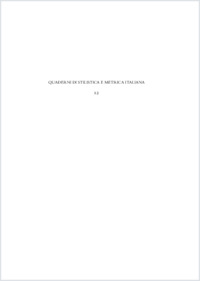Le madrigal la «Grande Forme» : L’exemple des sextines de Roland de Lassus
BLE-BLL
- Giardina, Adriano ORCID Université de Fribourg
- 2023
Published in:
- Contrainte créatrice. La fortune littéraire de la sextine dans le temps et dans l'espace / Babrieri, Luca ; Uhlig, Marion. - Firenze : SISMEL - Edizione del Galluzzo. - 2023, p. 225-263
English
A significant part of Orlando di Lasso’s output is made up of extensive works, multi-sectional or forming “cycles”. They allow the composer to show his creative power and, through the strong images conveyed by the chosen texts, to build up “large frescos”. It is therefore not surprising that Lasso was particularly interested in the sestina. Seven complete settings, a substantial number, are found in his catalogue. The musician’s taste for playing with language also accounted for this appeal. Although most of his madrigals belong to his Italian period, only the first three sestinas were probably composed in the peninsula. The others were written in Bavaria. The selected poets were Gabriele Fiamma, Petrarch, Federico Asinari and perhaps Stefano Ambrosio Schiappalaria. Two sestinas remain anonymous. These pieces are given prominent positions in the publications under Lasso’s supervision. They open or close the books and thus give them a particular weight. “Large scale form” is a musicology recurring concern and appears in analyses of sixteenth century sestinas and/or multi-sectional works by Lasso. However, it reflects an anachronistic organic conception. This is why I single out a rhetorical perspective in this paper. From this point of view, the most interesting sestina is for five voices, published in in Rome in 1563. In this piece, Lasso changes the number of voices throughout the parts: five in the two first ones, three in the third, and then adding one voice in each subsequent part, resulting in six voices being required in the last. The listener can therefore anticipate one of the unfolding aspect of this large work, an important feature in sustaining his or her attention. Thanks to its many voices, the last part is working as a peroration. This characteristic is strengthened by textural effects referring to polychoral dialogue. Moreover, Lasso highlights recurring affects, especially those occurring in the end-words, thanks to a complex network of musical devices (vocal range, melodic movement, harmonic context, cadences, cantus mollis and hypotyposis according to the terminology of Joachim Burmeister). He establishes a polarity between the end-words and . These expressiones textus operate at a local level. Their varied repetitions provide auditory cues that guide listening over time, as well as helping perception of a long text and highlighting the basic formal component of the poetic form. Except in for five voices, Lasso creates similar mimetic networks in his other sestinas.
- Faculty
- Faculté des lettres et des sciences humaines
- Department
- Département de musicologie
- Language
-
- French
- Classification
- Music
- License
- CC BY-NC-ND
- Open access status
- gold
- Identifiers
-
- DOI 10.36167/QSMI12PDF
- ISSN 2039-621X
- ISBN 9788892902374
- Persistent URL
- https://folia.unifr.ch/unifr/documents/325687
Statistics
Document views: 67
File downloads:
- 10-giardina_225-264.qxp_01-rimeperocchio.pdf: 163
